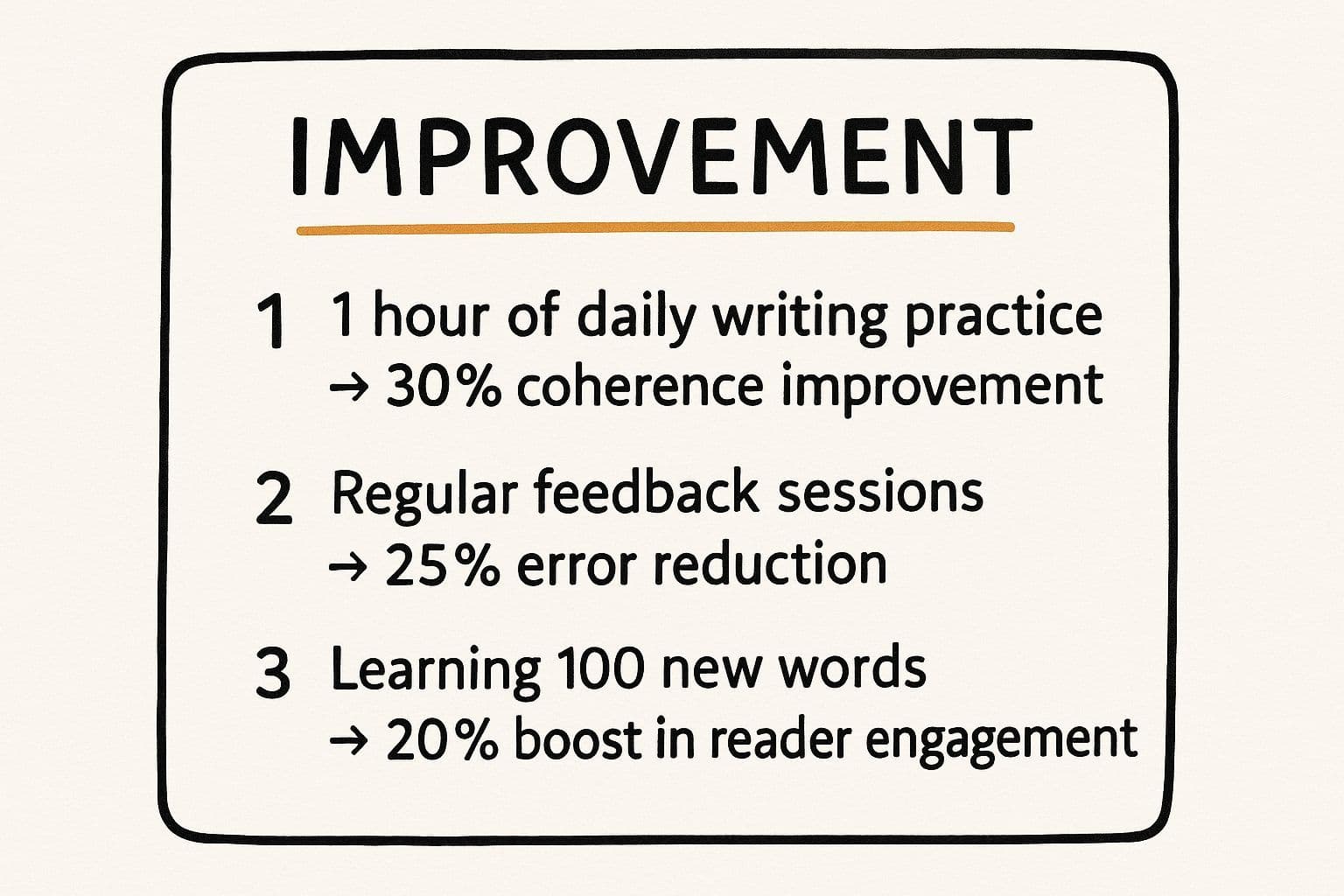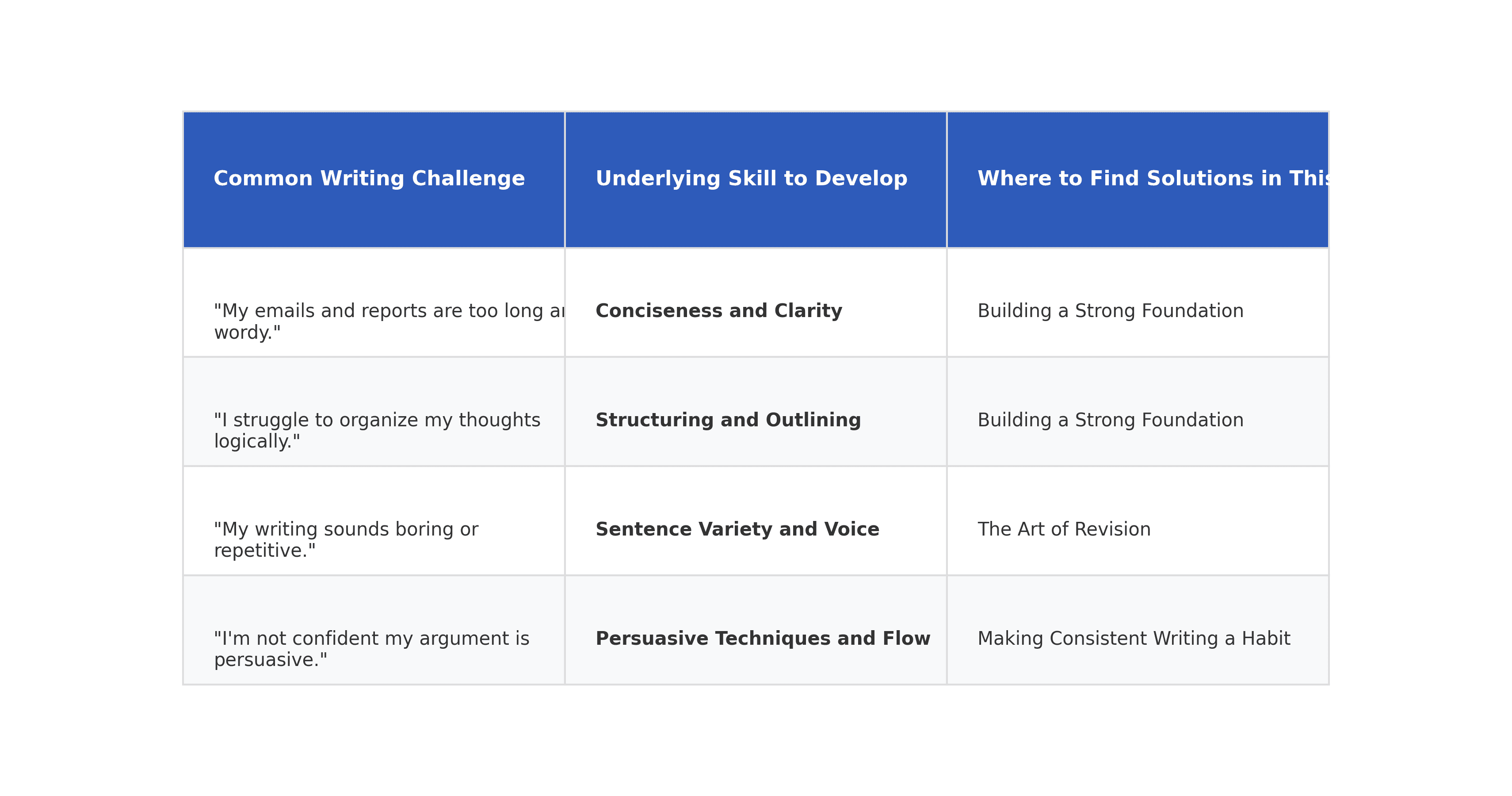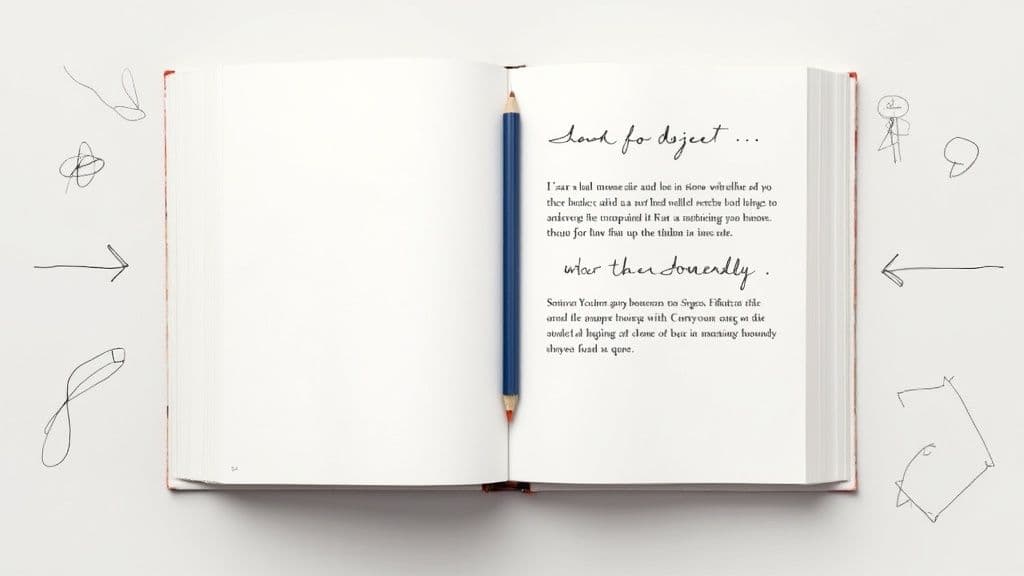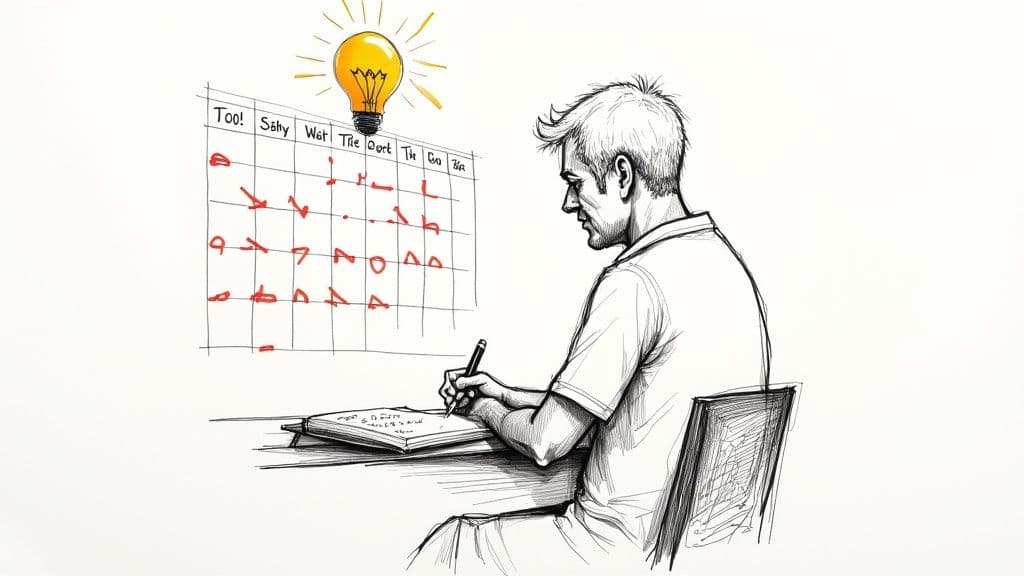Tutorial
How to Improve Writing Skills A Proven Guide
Improving your writing really just boils down to three things: consistent practice, reading everything you can get your hands on, and being willing to tear your own work apart and rebuild it. This guide is your roadmap to turning those actions into habits, helping you write with more clarity, confidence, and punch.
Why Better Writing Unlocks Career Growth
Let's be honest, strong writing is a professional superpower. It's not just about avoiding typos; it’s a direct line to getting what you want in your career. Your ability to get ideas out of your head and onto the page clearly and persuasively shapes how effective you are, period.
Think about it. A crisp project proposal, a direct and unambiguous email, a clear update to stakeholders—your words are out there doing the work for you. They’re building trust, driving decisions, and quietly showcasing your expertise when you're not even in the room.
On the flip side, weak writing is like throwing sand in the gears. It creates confusion, wastes everyone's time, and makes things harder than they need to be. The data doesn't lie: a study found 73% of professionals feel their workday is bogged down by unclear communication. Even more telling? A massive 87% of executives see strong writing as a critical leadership quality. Get more insights on this from PMCtraining.com's report on writing proficiency.
Bridging The Gap From Frustration To Fluency
So many of us know our writing could be better, but figuring out how to start feels overwhelming. Maybe you stare at a blank page, wrestle with a complex idea you can't quite articulate, or just have that nagging feeling that your message isn't landing right.
These are just symptoms. The good news is that for every common writing struggle, there's an underlying skill you can strengthen. Once you identify the root cause, you can stop guessing and start focusing your efforts where they'll make a real difference.
> "Clear writing is a sign of clear thinking. Great writers know how to communicate, and they make things easy for their readers."
> – Jason Fried, Co-founder of 37signals
Jason Fried hit the nail on the head. The goal isn't to sound smart by using complicated language. The goal is to make complicated ideas feel simple and accessible to your reader.
Look at how targeted effort pays off. Small, consistent actions lead to huge gains.

As you can see, investing a little time in the right places directly improves how clear your writing is and how well it connects with your audience.
Your Roadmap To Stronger Writing
To get you started, I've put together a quick-glance table connecting everyday writing problems with the foundational skills that solve them. Use it to pinpoint where you should focus your energy as you work through this guide.
From Common Writing Challenge to Core Skill

Think of this as your diagnostic tool. Find your biggest frustration in the first column, and you'll know exactly which skill—and which part of this guide—will help you fix it.
Building a Strong Foundation for Clear Writing

Most of us learned that good writing just means following the rules of grammar. And while grammar is definitely important, truly powerful writing goes way deeper than that. It’s really about building a solid base of clarity, precision, and rhythm that makes your ideas easy for people to understand and act on.
Think of it like building a house. You wouldn’t just start putting up walls without first pouring a solid concrete foundation. In writing, that foundation is made up of simple syntax, precise word choice, and varied sentence structures. Once you get these fundamentals down, every other part of the writing process gets a whole lot easier.
This isn't just a hunch; emerging research in the "Science of Writing" backs it up. Studies show that real improvement comes from mastering a web of interconnected cognitive skills. It’s not just about grammar—it includes everything from syntax and vocabulary to the executive functions you need to plan and revise your work. This research highlights just how demanding writing is on the brain, and that mastering these foundational skills frees up mental bandwidth for higher-level thinking. You can dive deeper into how these components work together by reading the full research on writing development.
Master Simplicity and Syntax
Your goal isn't to sound like a dusty academic paper; it's to be understood. The quickest path to better writing is to embrace simplicity. This starts with your sentence structure, also known as syntax. The clearest writing almost always favors a direct, subject-verb-object construction.
Instead of writing: “The report was reviewed by the marketing team, and it was concluded that the data was insufficient.”
Try this: “The marketing team reviewed the report and concluded the data was insufficient.”
See the difference? The second version is shorter, more active, and instantly clear. It gets rid of the passive voice and fluff words, putting the doer (the marketing team) right at the front. This tiny shift makes a massive difference in how readable your writing is.
> A simple way to practice this is what I call the "verb hunt." Pull up a recent email you wrote and highlight all the "to be" verbs (is, are, was, were). Then, challenge yourself to rewrite those sentences using stronger, more active verbs.
Cultivate a Precise Vocabulary
Using simple language doesn't mean your vocabulary has to be basic. It means choosing the exact word for the job. Precision is everything. Vague words create confusion and make your reader do the hard work of guessing what you really mean.
Think about the difference between saying a project is "good" versus saying it is "efficient," "innovative," or "profitable." Each of those words paints a much clearer, more specific picture in the reader's mind.
Here’s a practical exercise to build this skill:
* Start a word bank: When you're reading an article or report and stumble upon a word that perfectly captures a situation, add it to a running list.
* Use it in context: Don't just memorize definitions. The next time you're writing, try to slot that new, more precise word into your work. For example, instead of saying a plan has "a lot of problems," you could say it has "significant logistical hurdles."
This focused effort on vocabulary will give your writing more punch without making it complicated. And if you're looking for more ways to strengthen your academic writing, check out our guide on 7 ways to improve your essays.
Escape Repetitive Sentence Structures
Does all of your writing sound the same? A monotonous sentence structure can make even the most fascinating topic feel like a slog. The fix is to consciously mix up your sentence lengths and patterns.
When you blend short, punchy sentences with longer, more descriptive ones, you create a natural rhythm that keeps your reader hooked.
* Short sentences: Perfect for making a bold point. They create impact. They grab attention.
* Medium sentences: These are the workhorses of your writing. Use them to explain ideas and connect your thoughts.
* Long sentences: You can use these to group related ideas or add rich detail, but use them sparingly so you don't overwhelm the reader.
Give the "Sentence Variety Challenge" a try on your next draft. Read a paragraph out loud. If every sentence starts the same way or is roughly the same length, rewrite it. This simple revision trick can instantly make your writing more dynamic and professional.
Making Consistent Writing a Realistic Habit

The biggest myth about getting better at writing is that you need to make some huge, life-altering commitment. The reality is a lot less dramatic but way more effective: real progress comes from small, consistent, and deliberate practice. So, let's just forget the intimidating advice to "write every day."
Instead, we're going to build a realistic framework that actually fits into a schedule that’s already packed. The goal isn't to churn out a masterpiece every single day. It's to build a routine that sticks, one that sharpens your skills over time without burning you out.
Embrace Micro Writing Sessions
You don't need a solid hour of monk-like silence to make progress. In fact, thinking you do is probably the biggest reason you haven't started. The real trick is finding those tiny pockets of time and putting them to good use.
This is where micro-writing comes into play. It’s the simple practice of writing in short, focused bursts of just 10-15 minutes. This lowers the barrier so much that it almost feels harder not to do it.
Here are a few micro-writing ideas you can knock out in less time than it takes to make a coffee:
* Summarize a concept: Grab a complex idea from an article, a book, or even a meeting. Now, explain it in just three sentences. This is a killer exercise for practicing clarity.
* Describe an object: Look at your desk, pick something, and describe it using as much sensory detail as you can muster. You'll be surprised how much this sharpens your descriptive skills.
* Rewrite a bad email: We all get them. Find a poorly written email in your inbox and rewrite it to be clearer, more concise, and more professional. This is practical, real-world skill-building.
The power of this method is all about frequency. Five 10-minute sessions scattered through your week are infinitely more valuable than one stressful hour blocked off on a Sunday.
> "The secret to getting ahead is getting started. The secret of getting started is breaking your complex overwhelming tasks into small manageable tasks, and then starting on the first one."
This idea is the very heart of micro-writing. You make the task so small that your brain can't find an excuse to resist, which lets consistency finally take hold.
Use Journaling to Clarify Your Thoughts
Journaling isn't just for logging what you had for lunch. It's a powerful tool for untangling the mess of thoughts in your head. Think of it as a private gym for your writing muscles, a low-stakes place where you can write freely without worrying about an audience.
By regularly getting your thoughts down on paper, you're practicing the fundamental skill of turning abstract ideas into concrete words. This is the bridge to every other form of writing. If you struggle with complex topics, a solid journaling habit can be a game-changer. For students wanting to apply this kind of clarity to their papers, our guide on how to write an essay like a pro this semester offers specific techniques that build directly on this foundational practice.
Create a Simple Feedback Loop
Writing in a vacuum is the fastest way to hit a plateau. To actually get better, you need an outside perspective. But asking for feedback doesn't have to be some formal, scary process.
Set up a simple, informal feedback loop with a colleague or friend you trust. The key here is to be incredibly specific with what you ask for. Don't just toss a document over and ask, "Is this good?" That's useless. Guide them with targeted questions.

This approach gets you actionable insights you can use right away. It turns feedback from something to dread into a genuine tool for growth. Making this a regular, low-pressure exchange helps you spot your own blind spots and see your work with fresh eyes.
Think Like an Editor: The Art of Revision

So many writers treat the first draft like it's the main event. Editing, to them, is just a quick cleanup job before hitting publish. That’s a huge mistake. The real magic—where good ideas are forged into great writing—happens during revision.
It’s time to stop thinking of editing as a chore and start thinking like an editor.
Use our Free AI Detector to check your content
An editor’s mindset isn't just about catching typos. It’s about taking a step back, seeing the piece with fresh eyes, and being absolutely ruthless in the service of clarity. This is how you turn a jumble of sentences into something cohesive, persuasive, and truly polished.
The key is to not get overwhelmed. You don't fix everything at once. Instead, you work in layers, making multiple passes with a specific focus each time.
The Big Picture Edit: Nailing Structure and Flow
Before you even think about comma placement, you need to look at the architecture of your writing. This is the "big picture" or developmental edit. You’re basically checking if the foundation is solid.
Ask yourself a few hard questions:
* Is my main point obvious? Could someone read this once and tell you exactly what it's about?
* Does the logic track? Does each section build on the last in a way that feels natural, or are there weird jumps?
* What’s missing or out of place? Are there gaping holes in my argument? Could a paragraph be stronger if I moved it?
One of the best tricks I've ever learned for this is the reverse outline. Forget outlining before you write—create one from your finished draft. Just go through your piece and jot down the main point of each paragraph.
When you look at that new list, the structure of your writing becomes glaringly obvious. You'll immediately see where the flow breaks down or where your logic takes a confusing detour. It's a game-changer for improving coherence.
The Line-by-Line Review: Maximizing Clarity and Impact
Once the structure feels right, it's time to zoom in on the sentence level. This is where you polish your prose and make every single word pull its weight. Your goal is simple: make the writing as clear, concise, and engaging as possible.
This pass is all about tightening. You're hunting for anything that dilutes your message—think filler words, passive voice, and tired clichés.
Here's a quick hit list of things to slash:
* Filler Words: Words like just, really, very, basically, and in order to add fluff, not meaning. Cut them.
* Passive Voice: Find sentences where the subject is being acted upon (e.g., "The decision was made by the team"). Flip them to the active voice for more energy ("The team made the decision").
* Awkward Phrasing: If a sentence feels clunky when you read it, it is. This is where your secret weapon comes in.
> Reading your work out loud is a surprisingly powerful editing trick. Your ears will catch the awkward rhythms, repetitive sentences, and clumsy phrases that your eyes skim right over. Give it a try.
The Final Polish: A Meticulous Proofread
This is it—the last, crucial step before you send your work out into the world. You're no longer editing for style or structure. You are simply hunting for errors. This requires a completely different, detail-obsessed mindset.
By this stage, your brain is so familiar with the text that it starts to play tricks on you, showing you what you meant to write, not what's actually there. You have to force yourself to slow down.
Here are a couple of pro tricks to make your proofreading count:
1. Change the Scenery: Temporarily change the font, text size, or even the document's background color. This visual disruption tricks your brain into seeing the text fresh.
2. Read it Backwards: Start with the very last sentence and read your way to the top, one sentence at a time. This shatters the narrative flow and forces you to focus only on the mechanics of each individual sentence.
By adopting this layered approach, you separate the different jobs of shaping, refining, and polishing. It’s a methodical process that will consistently level up your writing, turning every rough draft into something you can be proud of.
Using Modern Tools to Sharpen Your Skills
Let's be honest, technology gives writers some incredible shortcuts. But it’s a bit of a double-edged sword.
It’s tempting to let a tool do all the heavy lifting, but real improvement comes from using tech as a collaborator, not a crutch. The idea is to let these modern tools handle the tedious, mechanical stuff. That frees up your brainpower for the creative and strategic thinking that actually makes your writing good.
When you start thinking this way, the tools transform from simple error-fixers into powerful teachers. Instead of blindly accepting a suggestion, you start to question it, understand the logic behind it, and absorb that lesson for the next time. It’s all about creating a smart partnership—using technology to sharpen your own skills, not to replace them.
Using AI as a Brainstorming Partner
One of the best ways to bring AI into your writing process is right at the very beginning—when you’re staring down a blank page. Instead of asking it to write for you, use it as a smart sounding board to get your own thoughts rolling. This is where you can genuinely learn **how to improve writing skills** by seeing a topic from a bunch of different angles.
Treat it like you would a research assistant by giving it specific, thought-provoking prompts:
* Uncover different angles: "Give me three counterarguments to the idea that remote work boosts productivity."
* Structure your thoughts: "Outline a blog post about the benefits of daily journaling for professionals. I need sections on clarity, problem-solving, and emotional regulation."
* Find new ways to explain things: "What are some simple analogies to explain the concept of compound interest?"
When you use AI like this, you’re always the one in control. It provides the raw material, but you’re the one who evaluates, organizes, and weaves those ideas into a solid argument in your own unique voice. This process does wonders for strengthening your critical thinking and structuring skills. If you want to go deeper, we've got a whole guide on using AI as your personal writing coach.
Turning Grammar Checkers into Learning Tools
Tools like [Grammarly](https://www.grammarly.com/) and the [Hemingway App](https://hemingwayapp.com/) are fantastic for catching mistakes, but their real power is unlocked when you treat their suggestions like micro-lessons. Don't just mindlessly click "accept" on every change. Take a second to figure out *why* the tool made that suggestion.
> The most effective writers don't just fix errors; they learn from them. Every highlighted mistake is an opportunity to permanently upgrade your writing toolkit, ensuring you're less likely to make the same error in the future.
For instance, take a look at the kind of feedback a tool like Grammarly offers.
This screenshot shows corrections for conciseness and clarity—basically, ways to make sentences more direct and punchy. Instead of just accepting them, ask yourself: Was my original sentence written in the passive voice? Did I toss in unnecessary filler words? This kind of reflection is what turns a quick fix into a skill that sticks.
The Rise of AI in Professional Writing
The explosion of AI writing tools is completely shaking up how professionals work. It's not just about writing faster; it's about reallocating human creativity where it matters most.
The numbers are pretty staggering. Organizations using AI writing software have seen a 59% reduction in content creation time and a 77% increase in how much content they produce in just six months. On top of that, 68% of repetitive writing tasks, like cranking out basic social media posts, are now being handed over to AI. This frees up human writers for more complex, strategic work. You can dig into more data on how AI is reshaping content production on FirewireDigital.com.
This big shift really highlights why you need to use AI strategically. Sure, the tools can handle volume and repetitive stuff, but the demand for skilled human writers—the ones who guide strategy, inject personality, and double-check for accuracy—has never been higher.
Your goal should be to build a workflow where technology helps you out, but you're the one calling the shots. Use AI to spark ideas, lean on grammar tools to polish your mechanics, and always, always proofread your own work. It's a balanced approach that ensures you're not just producing better work right now, but actively becoming a better writer for the long haul.
As you dig in and start applying these writing strategies, a few practical questions are bound to pop up. This happens to everyone. Getting good answers to these common sticking points is crucial for keeping your momentum going.
Let’s tackle some of the most frequent questions I hear from writers trying to level up their skills.
How Long Does It Take to See Real Improvement in Writing?
This is the big one, isn't it? The honest-to-goodness answer is that it really depends on how consistently you put in the work. Real improvement isn't some finish line you cross after a few weeks. It’s a slow burn, built on small, consistent efforts that add up over time.
Instead of staring at the calendar, I suggest focusing on one skill at a time. For instance, you could spend a month ruthlessly hunting down and eliminating passive voice in everything you write. The next month? Work on varying your sentence length. When you concentrate on these small, manageable pieces, you'll start to see tangible progress in just a couple of months as these habits become second nature.
What Is the Single Most Effective Daily Writing Exercise?
If I had to bet on just one exercise, it would be freewriting for 10 minutes every single day. It’s deceptively simple but incredibly powerful for building your writing muscles.
The rules are easy: set a timer for 10 minutes and just write. Don't stop, don't edit, and definitely don't judge what's coming out. The only goal is to keep your fingers moving. That's it.
> This simple habit does three powerful things: it demolishes writer's block by making writing a low-stakes activity, it strengthens the connection between your thoughts and your words, and it often uncovers ideas you didn't even know you had.
This isn't about producing something polished. It's about the raw act of getting words out of your head and onto the page, which is the foundation for everything else.
Can Reading More Actually Make Me a Better Writer?
Absolutely. But there’s a catch: you have to practice active reading. Just passively consuming articles or books won't cut it. Active reading means you’re reading like a writer, taking apart the text to see what makes it tick.
The next time you read something that really grabs you—a blog post, a novel, even a sharp email—don't just move on. Pause and ask yourself a few questions:
* Structure: How did the writer organize this? Where did they put the most important point?
* Word Choice: Are there any specific verbs or adjectives that create a certain feeling?
* Flow: How do they move from one idea to the next without it feeling clunky?
Analyzing writing this way is like getting a backstage pass to a master's workshop. You start to see the framework and the techniques, which you can then borrow and adapt for your own stuff.
How Do I Get Honest and Actionable Feedback?
Getting feedback that you can actually use is less about who you ask and more about how you ask. Just handing your work to someone and asking, "What do you think?" almost always leads to vague, unhelpful answers like "It's good!"
If you want real, constructive feedback, you have to guide your reviewer with specific questions. This turns them from a simple proofreader into a valuable partner.
Instead of the generic "Is this good?" try asking things like:
1. Clarity: "Was there any point where my main argument got fuzzy or confusing?"
2. Engagement: "Did you find any section boring? Where did you feel the urge to start skimming?"
3. Awkwardness: "Can you point out one or two sentences that just felt clunky or awkward to read out loud?"
This approach does two things. First, it gives your reviewer something concrete to look for, making their job easier. Second, and more importantly, it gives you specific, actionable advice you can use to improve the piece right away.
---
Ready to take your writing from good to great? StealthGPT can help you refine your drafts, generate ideas, and humanize your content to sound polished and professional. Discover how our AI-powered writing assistant can sharpen your skills at https://stealthgpt.ai.